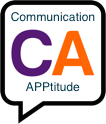 |
| How to Ask Questions |
So, in this example, I move my car forward by asking something like,
Beth Q: Do you have plans for this summer?
John A: Yes, we're going to the beach.
Beth C and Q: That sounds fun, which beach?
John A: Bethany Beach.
Beth C and Q: I love that beach! Who is going with you?
John A: My mom, dad and sister.
Beth C and Q: I bet you are going to have so much fun. When are you going/how long will you be gone?
John A: Two weeks in July.
Beth C: Wow, sounds like a great vacation!
BUT THAT IS JUST HALF OF THE CONVERSATION...
Most of my students will sit in awkward silence if I end the conversation there, and do not continue to ask them questions that focus entirely on them. That has become their comfort-zone. Adults and peers with solid conversation skills--to avoid the discomfort of the silence--typically meet the student more than half way, asking question after question about the student. That student, then, does not experience the "natural consequence" (awkward feeling) of failing to extend the conversation, and therefore has no opportunity to repair and learn how to extend and show interest in the other person.
More on conversation skills in a couple of weeks...








